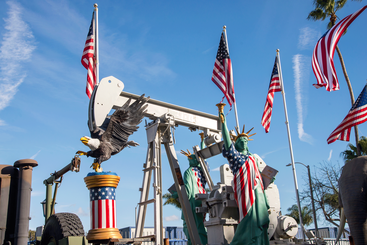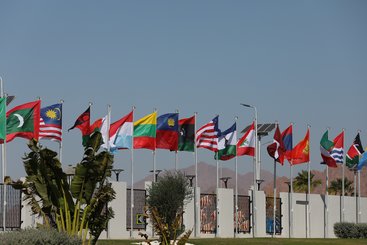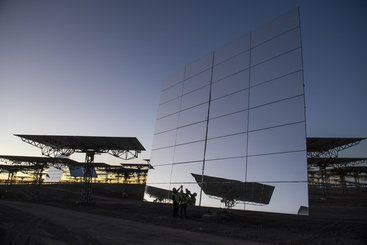At the COP28 climate summit in Dubai, vulnerable countries will continue to ask wealthy countries for new government budget funding (e.g. grants) to fight climate change. The political reality, though, is that governments, like the U.S., will not come up with vast amounts of new money anytime soon – particularly during election years. The more practical solution that can help deliver on our climate goals is to demand that money be spent differently.
The Loss & Damage Fund created during COP27, held a year ago in Egypt, and the Bridgetown Initiative both seek more resources: new funds, reallocation of Special Drawing Rights, callable capital, etc. – all more money. Yet each effort has made little progress in this fiscally constrained world, with few governments committing additional grants.
However, if we change the financial expectations of development finance institutions (DFIs) and multilateral development banks (MDBs), significantly increasing the availability of blended financing tools (e.g. grants, concessional lending, etc.), the world will be better positioned to deliver on climate action.
For decades, DFIs and MDBs have pursued profit, even if modest, sometimes at the expense of development impact. A public development bank’s purpose is not to make money; it is to use financing as one of many tools, including grants, to advance development.
This concept got lost when governments created these institutions with credit ratings and shareholders who bought into the notion that we could lift people out of poverty at no cost or very little cost to their taxpayers. While shareholders of these institutions do not expect to make a large profit, they do expect the entities themselves to break even and earn a few percentage points on their portfolios. That expectation must change.
Many DFI and MDB investments, particularly loans to large businesses or to banks in middle-income countries, can earn high returns while also promoting development. They should continue to make these types of investments so long as they are necessary to promote development and do not crowd out the private sector.
However, DFI and MDB financing has yet to scale in low-income countries. In 50 years, only six countries have emerged from least developed country (LDC) status. There remain another 46 LDCs.
In addition, there are 39 small island developing states (SIDS) and another 18 associate countries. While some SIDS are high-income countries, as my ODI colleague Emily Wilkinson recently pointed out in The Economist, SIDS ‘are generally too small to foster diversified economies or to reap the benefits of scale, and too distant from big markets. That means they struggle to attract private capital’. While these countries account for a tiny percentage of the world’s population, land, and GDP, they also tend to get hit the hardest by climate events – events that can destroy their entire economies instantly. It’s not inexpensive or particularly lucrative for MDBs and DFIs to conduct business in SIDS, but there is a tremendous development need in those countries, which can be helped with inexpensive financing.
Public institutions should not earn a high financial return on those projects directed at the people, small businesses, and countries who have the least money and greatest need, if doing so comes at the expense of development impact. Too heavy a focus on returns could mean that electricity costs for the poor will be higher, or that small-holder farmers will not be able to secure loans at reasonable interest rates. While MDBs and DFIs tend to have some of the lowest cost of capital in the world already, they can lower those costs even more to effect strategic change if they have more grant money to further reduce the cost of their financing. This concept of blended financing, if scaled significantly and accompanied by the other reforms and capacity-building desperately needed in many LDCs, offers the promise of leveraging grant capital into multiples of lending, putting us on the elusive road of billions to trillions.
The U.S. Congress tried to correct this flaw in the development finance architecture by establishing its own DFI, the U.S. International Development Finance Corporation (DFC). DFC generally makes a profit on a portfolio-wide basis, but it is not required to earn a return at all. All countries that provide development lending should follow the model of prioritizing impact and eliminating the requirement for net positive returns.
‘Requiring payment in U.S. dollars is not a recipe for low-cost electricity and sustainable development; it is a recipe for potential default and sustained poverty.’
Development lenders also should take on currency risk when doing so will advance a strategic goal such as lending in low-income countries, or to small businesses, or for a strategic infrastructure project. Yet, most cannot do so directly. The World Bank’s lending arms either are not permitted to take on open foreign exchange risk exposure or are not permitted to lend directly in local currency. A solar plant developer in Liberia needs U.S. dollars to buy equipment in the global market, but its customers pay for electricity in Liberian dollars. Since 2000, the Liberian dollar has lost 73% of its value against the U.S. dollar. The price of electricity will have to increase significantly to repay U.S. dollar-denominated debt, undermining the deal’s primary purpose of delivering low-cost, reliable electricity to a low-income, growing economy. While many MDBs and DFIs can offer lending in local currency by deploying currency hedging tools, those tools are not free. The risk of the currency depreciation (i.e., the cost of the hedging tool) is built into the cost of the loan – a very high cost that gets passed on to the borrower through high interest rates.
Requiring payment in U.S. dollars is not a recipe for low-cost electricity and sustainable development; it is a recipe for potential default and sustained poverty. Development lenders agreeing to absorb some of the currency depreciation risk could unleash new investment in the world’s most vulnerable countries.
While more money is important, COP28 should focus on spending money more efficiently. Grants can be repurposed to secure better financing, which will deliver more projects for the countries and people that need investment the most.



